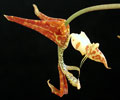|
|
|
|
|
| |
Flasks of
Gongora rufescens 'MC2571' × self |
|
| |
|
|
| |
| Number: |
TN4302 |
| Name: |
Gongora rufescens 'MC2571' × self
(Acquired incorrectly named as Gongora histrionica)
|
| Type: |
self (What's that?) |
|
Click to Enlarge

Pod Parent Flower |
Click to Enlarge

Pod Parent Flowers |
Click to Enlarge

Offspring 'MC5637' Flower |
Click to Enlarge

Offspring 'MC5637' Inflorescence |
Click to Enlarge

Offspring 'MC5637' Top View of Flower |
| Offspring photos are siblings of the plants you would receive. |
|
|
|
| |
Culture Notes from Donor: Parent plant: Temperature range I (60-83°F)
Comments: Parent plant: This is an adult plant which has proven very floriferous. There are about 20-25 flowers per inflorescence and they last 8 - 10 days. This plant has flowered for us from late summer to early winter and is now sending out new spikes already. The vendor sold it to us as Gongora histrionica but it flowered much darker than any picture we found of this species, and has since been ID'd as rufescens by Rudolf Jenny. Culture is the same as for many gongoras, intermediate to warm temperatures, good humidity, frequent waterings, and light shade. Medium-sized plant.
For additional origin/habitat information supplied courtesy of
Charles and Margaret Baker, see further below, near the bottom of this page.
|
Temperatures we attempt to use in the lab & greenhouse:
| For Species: |
|
Spring, Summer, Autumn, Winter: days average 75°F, nights 68°F; best fit is Intermediate 83-60°F
(Source:
Baker's Web OSC) |
|
About the name...
| Etymology of |
Gongora |
|
Named for Don Antonio Caballero y Góngora, viceroy of New Granada (Colombia) during the 18th century.
(Source:
Pridgeon 1992) |
| Etymology of |
rufescens |
|
From Latin "rufescens" light fox-red.
(Source:
Mayr & Schmucker 1998) |
| Pronunciation of |
Gongora |
|
GON-goe-ra
(Source:
Pridgeon 1992) |
|
If you would like to direct someone to this web page, please copy and paste this URL into your email:
http://troymeyers.com/d?014302
| Flask Information |
| Availability: |
We have sold all of the flasks for this item. |
| You should: |
Consider getting individual plants or compots instead of a flask.
You can place a "Notify Flask Recipients" Request, and either we or a flask recipient may contact you when plants are available.
You may also place a "Notify Retries" Request, and if an identical pollination (the same parents) is done again, we'll let you know.
You may reserve a flask, but it's very unlikely you'll get one ...this could only happen if we found a flask that we didn't know we had. |
| Yield Estimate: |
360 plants (based on flask surveys done 08/30/2004 through 01/12/2006)
|
| Plantlet Sizes: |
From many flasks 30 - 110 mm plants (based on flask surveys done 10/13/2004 through 05/30/2006)
From one most recently surveyed flask 40 - 100 mm (05/30/2006)
|
|
You might also want to:
|
View the seed assay for this item.
View items of the same species.
View items of the same genus.
|
| Ordering Information |
| You are not currently logged in. |
|
You must be a registered user and be logged in to reserve a flask or place a notification request. Please log in:
|
|
|
|
|
|
| |
The origin/habitat information below is supplied courtesy of Charles and Margaret Baker
The following information is based on the name of the plant provided by the donor, and assumes that the name is correct. If the plant has been misidentified, then the following information may not be correct.
This text is copyrighted by the Bakers and may not be reproduced without permission.
ORIGIN/HABITAT: Colombia. The type specimen was collected in the
Department of Narino in southwestern Colombia just north of the border
with Ecuador. No specific habitat location, type, or elevation were
reported, so the following climate data and cultural suggestions should be
used with a great deal of caution.
More about this information and the Bakers...
|
|
|
| |
|
|
|